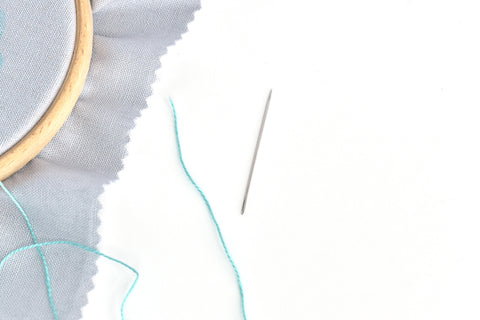Teaching Children Embroidery

Want to teach kids how to stitch? If you want to spread the joy of embroidery to your young people, follow these helpful tips to set kids up for success!
Embroidery, cross-stitch, and needlepoint are fun for all ages and teach life long skills, but they do take practice. That's true for adults, and it's especially true for children who are still developing fine motor skills or who might have a short attention span. As you teach a child to stitch, keep your mindset positive so they can do the same.
1 Remember Your Why
When you teach kids to stitch, it's important to begin by remembering why you're helping them learn this new skill. Ultimately, stitching of any kind should be fun (okay, maybe not hemming curtains!). If you want a child to enjoy a new needlecraft, keep the goal of fun in mind as you work together.
2 Respond to Kids' Interests
If a child sees you stitching and enjoying the process they are likely to be interested and want to join in. However, instead of pushing a craft on kids, let them come to it in their own time. They'll be more likely to enjoy the process if they initiate it. Likewise, if a child starts to lose interest, don't force them to continue. Obviously, it's good to encourage children to keep trying without giving up, but it's better to take a break (see tip 9!), even for a long time, than to make this a negative experience.
3 Choose the Right Tools and Supplies

If you've ever worked with fraying materials, dull scissors, or a bad needle, you've probably been frustrated. That's even more true for kids. So often kits or supplies that are designed for kids are low-cost, which can equal low-quality. Children will have a much easier time learning how to stitch if the supplies work well.
Give kids the same supplies that you would want to work with as an adult. When selecting kits, look for designs that are easy and kid-friendly, but that include real tools and materials. Threads that don't need separating and are less likely to form knots, such as DMC perle cotton, can be helpful. Also, plastic canvas and tapestry wools can be great starting materials to try. We have a whole department with embroidery supplies for children.
4 Keep it Age-Appropriate
This might seem apparent, but a four-year-old won't be able to do the same things that a 12-year-old can do. At least not right away. Part of that is simply that smaller hands are still developing and don't have the same level of control that pre-teen hands do! Keep things much simpler for young children, both with the design that you work with and the materials you use. Even using a smaller hoop can help make it easier for kids to manage!
5 Be Pattern Prepared

Take the time to teach how to follow a pattern. Remember that sometimes as adults we think things are obvious, but kids may not immediately see the best way to make their way through a design. Give children the tools they need, but don't worry it if they stray from your guidance. If they don't follow the pattern exactly, it's okay!
For embroidery, it can help to use a wipe-off marking pen so that the lines disappear with a little water and you can't even see where things were a little off. For cross stitch and needlepoint, being off by a stitch never hurt anyone. But it can also be a perfect opportunity to practice taking out stitches and trying again.
Kids love seeing their own designs come to life so why not let them doodle their own design onto fabric, encouraging them to keep it simple to start!
6 Don't Lose the Needle

One of the biggest challenges that happens when kids do any kind of hand stitching is that the needle comes unthreaded. Sometimes with every stitch! The temptation is often to fold the thread in half and "lock" the needle on there, but that brings up problems if you have to undo any stitches. Instead, thread the needle and keep a long tail so it has more thread before coming off. Then, encourage kids to pinch the eye of the needle as they stitch. Before you know it, they will have learnt how to stop before the needle becomes unthreaded.

This is also a good time to teach them how to use a needle threader. Be sure to use a sturdy one so they aren't frustrated!
7 Use Simple Stitches

There's no need to use fancy stitches when you're learning. Running stitch is the ideal first stitch for children. It's just up and down! Once they've mastered that, they are ready to try similar stitches like straight stitch and cross stitch, then back stitch and split stitch.
8 Go Up and Down, but Not Around

Another pitfall that kids often run into when learning to stitch is forgetting which side of the fabric (or plastic canvas!) they are on. They've just gone down through the material and instead of coming up, they bring the needle around the edge and go back down. It makes a tangled mess! This really is just something that takes practice and it's one reason that running stitch is a good one to start with. It gives kids a chance to get into the rhythm of up, down, up, down.
This is also one more reason not to "lock" the needle on the thread. Odds are you'll see this common kid stitching issue happen and you want to be able to easily fix it!
9 Take Breaks Along the Way

Going back to tip number two, when kids need a break, take a break! They might need a few minutes of movement time or a few days to feel ready to face the stitching. This isn't unique to children…adults need this too! Use breaks to establish good habits. If they're taking a snack break, remind them to wash their hands before picking up their project. Keep needles safe by placing them on a needle minder. And if it's going to be a longer break put the project away neatly so it's ready for next time.
10 Celebrate Successes

No matter what the stitching looks like at the end, celebrate a job well done. Help kids frame their work or make it into a useable object. Show it off! But don't just reserve the celebration for actually finishing. Stitching is a rewarding hobby not only because you can make something but because the process itself is fun. If a child stitches a bunch of random stitches and they enjoyed it…that's still something to shout about!
With thanks to Mollie Johanson for these great tips.

Comments
Lisa said:
Thanks! My son has seen me start up some hand embroidery again recently and asked if he could try. It made me so happy that he was interested. Your tips were very helpful!
Jane Aldridge said:
Great to see your very helpful notes on how to stitch with children. It’s been my granddaughter’s half term this week and I’ve been showing her how to sew some simple embroidery stitches and she loved it! I used some Aida in a hoop which was useful to get good tension but not ideal as it was a bit fine. She had great results though and was delighted.